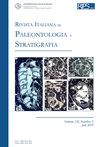作为非洲海岬的亚得里亚海及其在二叠纪特提斯扭曲和pangea b到pangea转变中的概念作用
IF 1.6
3区 地球科学
Q2 GEOLOGY
引用次数: 17
摘要
意大利北部特伦托高原(南阿尔卑斯山)早二叠世Bolzano石英斑岩的首次结果显示,古地磁倾角比中欧广泛同时代单元的倾角更陡,距今已近60年。这一实验差异从那时起就在不同的震级和确定度上得到了证实,这意味着意大利北部的古纬度相对于欧洲太北,不足以被视为欧洲大陆的一部分。另一方面,越来越明显的是,意大利北部的古地磁数据与非洲的数据比与欧洲的数据更为兼容,这一观测结果重新提出并补充了Argand关于亚得里亚海是非洲海角的原始概念。但是,如果亚得里亚海是非洲的一部分,那么当这些大陆被迫进入典型的韦格纳古大陆时,亚得里亚亚相对于欧洲的古纬度异常就转化为冈瓦纳大陆相对于劳拉西亚大陆的巨大地壳错配,这是以环大西洋大陆的布拉德适配为代表的。冈瓦纳大陆和劳拉西亚大陆之间的这种地壳错配现象在不断增长的古地磁数据库中持续存在,即使来自亚得里亚海的数据被暂时排除在非克拉通性质之外。提出了各种解决方案,最终包括将冈瓦纳大陆放置在相对于劳拉西亚大陆的东部(使其更北),并设想在这些超大陆之间的特提斯(地中海)地区发生右旋剪切。这种剪切或转换最初被认为是中新生代过程中的一个连续体(所谓的“特提斯扭曲”),但不久之后,当板块构造发挥作用并限制了较年轻的范围时,这是后三叠纪的一个离散事件,三叠纪,或者很可能是二叠纪,介于盘古大陆的B构造(非洲西北边缘与南欧的对比)和盘古大陆a-2构造(非洲东北边缘与北美东部的对比)之间,它的形状更接近于经典的盘古大陆A-1,盘古大陆在侏罗纪随着大西洋的开放而开始分裂。二叠纪的时间和推测的约2300公里右旋剪切的轨迹得到了撒丁岛和Lauarasia和Gondwana交界处其他地方旋转构造域的支持。因此,盘古大陆B的概念及其转变为盘古大陆A的过程与亚得里亚海作为非洲海角的概念和古地磁支持密切相关,并对构造、气候变化和生物地理学的许多方面产生了影响。本文章由计算机程序翻译,如有差异,请以英文原文为准。
Adria as promontory of Africa and its conceptual role in the tethys twist and pangea b to pangea a transformation in the permian
It has been almost 60 years since the first results from the Early Permian Bolzano Quartz Porphyries from the Trento Plateau of northern Italy (Southern Alps) showed paleomagnetic inclinations steeper than inclinations from broadly coeval units from central Europe. This experimental discrepancy, confirmed ever since at varying levels of magnitude and certitude, implied that northern Italy had paleolatitudes too northerly relative to Europe to be considered part of the European continent. On the other hand, it became progressively more apparent that paleomagnetic data from northern Italy were more compatible with data from Africa than with data from Europe, and this observation revived and complemented Argand’s original concept of Adria as a promontory of Africa. But if Adria was part of Africa, then the paleolatitude anomaly of Adria relative to Europe translated into a huge crustal misfit of Gondwana relative to Laurasia when these landmasses were forced into a classic Wegenerian Pangea as typified by the Bullard fit of the circum-Atlantic continents. This crustal misfit between Gondwana and Laurasia was shown to persist in the ever-growing paleomagnetic database even when data from Adria were provisionally excluded as non-cratonic in nature. Various solutions were offered that ultimately involved placing Gondwana to the east (allowing it to be more northerly) relative to Laurasia and envisaging a dextral shear occurring in the Tethys (Mediterranean) realm between these supercontinental landmasses. This shear or transformation was initially thought to occur as a continuum over the course of the Mesozoic–Cenozoic (the so-called ‘Tethys Twist’) but soon afterwards when plate tectonics came into play and limited the younger extent, as a discrete event during the post-Triassic, Triassic or most probably – as in the latest and preferred reconstructions – the Permian between a configuration of Pangea termed B – with the northwestern margin of Africa against southern Europe – to a configuration termed Pangea A-2, with the northwestern margin of Africa against eastern North America, that is more proximal in shape to the classic Pangea A-1 that started fragmenting in the Jurassic with the opening of the Atlantic Ocean. The Permian timing and presumed locus of the ~2300 km dextral shear is supported by rotated tectonic domains in Sardinia and elsewhere along the interface between Lauarasia and Gondwana. The concept of Pangea B and its transformation into Pangea A developed therefore in close conjunction with the concept and paleomagnetic support of Adria as a promontory of Africa, and has ramifications to many aspects of tectonics, climate change and biogeography yet to be explored.
求助全文
通过发布文献求助,成功后即可免费获取论文全文。
去求助
来源期刊
CiteScore
3.60
自引率
4.30%
发文量
28
审稿时长
>12 weeks
期刊介绍:
The Rivista Italiana di Paleontologia e Stratigrafia was founded in 1895. It publishes original papers dealing with all fields of paleontology and of stratigraphy, from Italy and the Mediterranean to the Tethys, as well across the globe from China to North America.

 求助内容:
求助内容: 应助结果提醒方式:
应助结果提醒方式:


